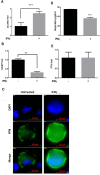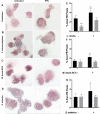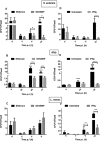Interferon-gamma promotes iron export in human macrophages to limit intracellular bacterial replication
- PMID: 33290416
- PMCID: PMC7723272
- DOI: 10.1371/journal.pone.0240949
Interferon-gamma promotes iron export in human macrophages to limit intracellular bacterial replication
Abstract
Salmonellosis and listeriosis together accounted for more than one third of foodborne illnesses in the United States and almost half the hospitalizations for gastrointestinal diseases in 2018 while tuberculosis afflicted over 10 million people worldwide causing almost 2 million deaths. Regardless of the intrinsic virulence differences among Listeria monocytogenes, Salmonella enterica and Mycobacterium tuberculosis, these intracellular pathogens share the ability to survive and persist inside the macrophage and other cells and thrive in iron rich environments. Interferon-gamma (IFN-γ) is a central cytokine in host defense against intracellular pathogens and has been shown to promote iron export in macrophages. We hypothesize that IFN-γ decreases iron availability to intracellular pathogens consequently limiting replication in these cells. In this study, we show that IFN-γ regulates the expression of iron-related proteins hepcidin, ferroportin, and ferritin to induce iron export from macrophages. Listeria monocytogenes, S. enterica, and M. tuberculosis infections significantly induce iron sequestration in human macrophages. In contrast, IFN-γ significantly reduces hepcidin secretion in S. enterica and M. tuberculosis infected macrophages. Similarly, IFN-γ-activated macrophages express higher ferroportin levels than untreated controls even after infection with L. monocytogenes bacilli; bacterial infection greatly down-regulates ferroportin expression. Collectively, IFN-γ significantly inhibits pathogen-associated intracellular iron sequestration in macrophages and consequently retards the growth of intracellular bacterial pathogens by decreasing iron availability.
Conflict of interest statement
The authors have declared that no competing interests exist.
Figures





Similar articles
-
Expression and localization of hepcidin in macrophages: a role in host defense against tuberculosis.J Leukoc Biol. 2007 Oct;82(4):934-45. doi: 10.1189/jlb.0407216. Epub 2007 Jul 3. J Leukoc Biol. 2007. PMID: 17609338
-
CpG oligonucleotides partially inhibit growth of Mycobacterium tuberculosis, but not Salmonella or Listeria, in human monocyte-derived macrophages.FEMS Immunol Med Microbiol. 2005 Aug 1;45(2):303-10. doi: 10.1016/j.femsim.2005.05.007. FEMS Immunol Med Microbiol. 2005. PMID: 16002269
-
Role of the hepcidin-ferroportin axis in pathogen-mediated intracellular iron sequestration in human phagocytic cells.Blood Adv. 2018 May 22;2(10):1089-1100. doi: 10.1182/bloodadvances.2017015255. Blood Adv. 2018. PMID: 29764842 Free PMC article.
-
Iron and innate antimicrobial immunity-Depriving the pathogen, defending the host.J Trace Elem Med Biol. 2018 Jul;48:118-133. doi: 10.1016/j.jtemb.2018.03.007. Epub 2018 Mar 10. J Trace Elem Med Biol. 2018. PMID: 29773170 Review.
-
Iron metabolism and the innate immune response to infection.Microbes Infect. 2012 Mar;14(3):207-16. doi: 10.1016/j.micinf.2011.10.001. Epub 2011 Oct 20. Microbes Infect. 2012. PMID: 22033148 Free PMC article. Review.
Cited by
-
The Roles of Inflammasomes in Host Defense against Mycobacterium tuberculosis.Pathogens. 2021 Jan 25;10(2):120. doi: 10.3390/pathogens10020120. Pathogens. 2021. PMID: 33503864 Free PMC article. Review.
-
Host Cell Amplification of Nutritional Stress Contributes To Persistence in Chlamydia trachomatis.mBio. 2022 Dec 20;13(6):e0271922. doi: 10.1128/mbio.02719-22. Epub 2022 Nov 15. mBio. 2022. PMID: 36377897 Free PMC article.
-
Designing of a Chimeric Vaccine Using EIS (Rv2416c) Protein Against Mycobacterium tuberculosis H37Rv: an Immunoinformatics Approach.Appl Biochem Biotechnol. 2022 Jan;194(1):187-214. doi: 10.1007/s12010-021-03760-0. Epub 2021 Nov 24. Appl Biochem Biotechnol. 2022. PMID: 34817805
-
Advances in Ferritin Physiology and Possible Implications in Bacterial Infection.Int J Mol Sci. 2023 Feb 28;24(5):4659. doi: 10.3390/ijms24054659. Int J Mol Sci. 2023. PMID: 36902088 Free PMC article. Review.
-
Iron-depleting nutritional immunity controls extracellular bacterial replication in Legionella pneumophila infections.Nat Commun. 2024 Sep 8;15(1):7848. doi: 10.1038/s41467-024-52184-x. Nat Commun. 2024. PMID: 39245746 Free PMC article.
References
-
- CDC. HIV/AIDS [Available from: https://www.cdc.gov/hiv/default.html.
-
- WHO. HIV [Available from: http://www.who.int/hiv/en/.
-
- ECDC/WHO. HIV/AIDS surveillance in Europe. 2016.
-
- CDC. Today’s HIV/AIDS epidemic 2016.
-
- Bureau USC. USA aging population [Available from: https://www.census.gov/quickfacts/fact/table/US/PST045216.
Publication types
MeSH terms
Substances
LinkOut - more resources
Full Text Sources
Medical
Molecular Biology Databases

